Bioprinciples Study guides, Study notes & Summaries
Looking for the best study guides, study notes and summaries about Bioprinciples? On this page you'll find 40 study documents about Bioprinciples.
All 40 results
Sort by

-
Bioprinciples Exam 2 – Brooks Questions and Answers 100% Pass
- Exam (elaborations) • 42 pages • 2024
-
- R260,11
- + learn more
Bioprinciples Exam 2 – Brooks Questions and Answers 100% Pass Cytology - Answer- the study of cells Robert Hooke - Answer- - observed cork could float - discovered a honeycomb-like structure in a cork slice using a primitive compound microscope - only saw cell walls as this was dead tissue - coined the term "cell" for these individual compartments he saw Two types of microscopes: - Answer- 1. Light Microscope 2. Electron Microscope Light Microscope - Answer- - light is focused on s...
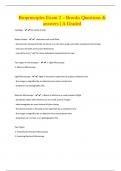
-
Bioprinciples Exam 2 – Brooks Questions & answers | A Graded
- Exam (elaborations) • 38 pages • 2024
-
- R240,83
- + learn more
Cytology - the study of cells Robert Hooke - - observed cork could float - discovered a honeycomb-like structure in a cork slice using a primitive compound microscope - only saw cell walls as this was dead tissue - coined the term "cCytology - the study of cells Robert Hooke - - observed cork could float - discovered a honeycomb-like structure in a cork slice using a primitive compound microscope - only saw cell walls as this was dead tissue - coined the term "cell" for these individu...
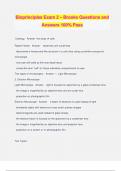
-
Bioprinciples Exam 2 – Brooks Questions and Answers 100% Pass
- Exam (elaborations) • 42 pages • 2024
- Available in package deal
-
- R260,11
- + learn more
Bioprinciples Exam 2 – Brooks Questions and Answers 100% Pass Cytology - Answer- the study of cells Robert Hooke - Answer- - observed cork could float - discovered a honeycomb-like structure in a cork slice using a primitive compound microscope - only saw cell walls as this was dead tissue - coined the term "cell" for these individual compartments he saw Two types of microscopes: - Answer- 1. Light Microscope 2. Electron Microscope Light Microscope - Answer- - light is focused on s...
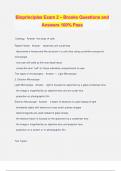
-
Bioprinciples Exam 2 – Brooks Questions and Answers 100% Pass
- Exam (elaborations) • 42 pages • 2024
- Available in package deal
-
- R260,11
- + learn more
Bioprinciples Exam 2 – Brooks Questions and Answers 100% Pass Cytology - Answer- the study of cells Robert Hooke - Answer- - observed cork could float - discovered a honeycomb-like structure in a cork slice using a primitive compound microscope - only saw cell walls as this was dead tissue - coined the term "cell" for these individual compartments he saw Two types of microscopes: - Answer- 1. Light Microscope 2. Electron Microscope Light Microscope - Answer- - light is focused on s...
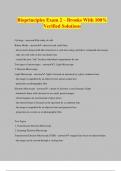
-
Bioprinciples Exam 2 – Brooks With 100% Verified Solutions
- Exam (elaborations) • 31 pages • 2024
- Available in package deal
-
- R260,11
- + learn more
Bioprinciples Exam 2 – Brooks With 100% Verified Solutions Cytology - answerthe study of cells Robert Hooke - answer- observed cork could float - discovered a honeycomb-like structure in a cork slice using a primitive compound microscope - only saw cell walls as this was dead tissue - coined the term "cell" for these individual compartments he saw Two types of microscopes: - answer1. Light Microscope 2. Electron Microscope Light Microscope - answer- light is focused on specimen by a...
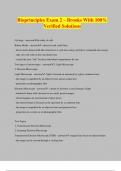
-
Bioprinciples Exam 2 – Brooks With 100% Verified Solutions
- Exam (elaborations) • 31 pages • 2024
- Available in package deal
-
- R260,11
- + learn more
Bioprinciples Exam 2 – Brooks With 100% Verified Solutions Cytology - answerthe study of cells Robert Hooke - answer- observed cork could float - discovered a honeycomb-like structure in a cork slice using a primitive compound microscope - only saw cell walls as this was dead tissue - coined the term "cell" for these individual compartments he saw Two types of microscopes: - answer1. Light Microscope 2. Electron Microscope Light Microscope - answer- light is focused on specimen by a...

-
Bioprinciples Exam 2 – Brooks Questions and Answers 100% Pass
- Exam (elaborations) • 42 pages • 2024
- Available in package deal
-
- R260,11
- + learn more
Bioprinciples Exam 2 – Brooks Questions and Answers 100% Pass Cytology - Answer- the study of cells Robert Hooke - Answer- - observed cork could float - discovered a honeycomb-like structure in a cork slice using a primitive compound microscope - only saw cell walls as this was dead tissue - coined the term "cell" for these individual compartments he saw Two types of microscopes: - Answer- 1. Light Microscope 2. Electron Microscope Light Microscope - Answer- - light is focused on s...
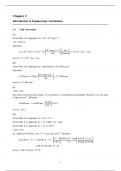
-
Bioprocess engineering principles solutions manual
- Exam (elaborations) • 416 pages • 2023
-
- R323,75
- + learn more
From Table A.9 (Appendix A): 1 cP = 10–3 kg m–1 s–1 1 m = 100 cm Therefore: 3 1 1 6 6 11 1 110 kg m s 1 m 1.5 10 cP = 1.5 10 cP . . 1.5 10 kg s cm 1 cP 100 cm − − − − − − − − × × = × Answer: 1.5 × 10–11 kg s–1 cm–1 (b) From Table A.8 (Appendix A): 1 hp (British) = 42.41 Btu min–1 Therefore: 1 142.41 Btu min 0.122 hp = 0.122 hp . 5.17 Btu min 1 hp − − = Answer: 5.17 Btu min–1 (c) 1 min = 60 s rpm means revolutions per minute. As revo...
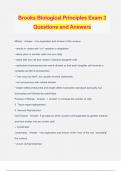
-
Brooks Biological Principles Exam 3 Questions and Answers
- Exam (elaborations) • 31 pages • 2024
-
- R260,11
- + learn more
Brooks Biological Principles Exam 3 Questions and Answers Mitosis - Answer- • the duplication and division of the nucleus • results in clones with *no* variation or adaptation • takes place in somatic cells (non-sex cells) • starts with one cell and creates 2 identical daughter cells • replicated chromosomes are evenly divided so that each daughter cell receives a complete set (46 chromosomes) • *can occur by itself*, but usually involves cytokinesis • not synonymous with ...

-
FAU Dr. Brooks - Biological Principles - Unit 3 Comprehensive Study Guide 2024 with complete Solutions
- Exam (elaborations) • 47 pages • 2024
-
- R260,11
- + learn more
FAU Dr. Brooks - Biological Principles - Unit 3 Comprehensive Study Guide 2024 with complete Solutions What is the cell theory? - Answer- All organisms are made come from cells and are made up of cells Cells must reproduce for what 2 reasons? - Answer- Cells must reproduce either to perpetuate the species or create a multi-celled individual Cell reproduction involves which two processes? - Answer- Cell reproduction involves mitosis (duplication and division of the nucleus) and cytokinesi...

How much did you already spend on Stuvia? Imagine there are plenty more of you out there paying for study notes, but this time YOU are the seller. Ka-ching! Discover all about earning on Stuvia


